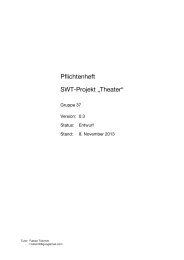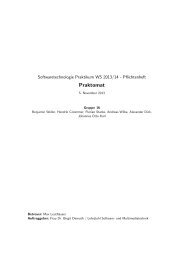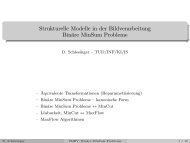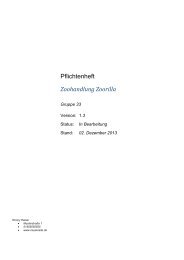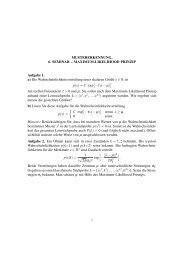Android, .Net Compact Framework and JXTA - Faculty of Computer ...
Android, .Net Compact Framework and JXTA - Faculty of Computer ...
Android, .Net Compact Framework and JXTA - Faculty of Computer ...
You also want an ePaper? Increase the reach of your titles
YUMPU automatically turns print PDFs into web optimized ePapers that Google loves.
Department <strong>of</strong> <strong>Computer</strong> Science Institute for System Architecture, Chair for <strong>Computer</strong> <strong>Net</strong>works<br />
Application Development for Mobile<br />
<strong>and</strong> Ubiquitous Computing<br />
10. Platforms -<br />
<strong>Android</strong>, .<strong>Net</strong> <strong>Compact</strong> <strong>Framework</strong><br />
<strong>and</strong> <strong>JXTA</strong><br />
Dr. Ing. Thomas Springer<br />
Technische Universität Dresden<br />
Chair <strong>of</strong> <strong>Computer</strong> <strong>Net</strong>works
Structure<br />
• <strong>Android</strong><br />
• .<strong>Net</strong> <strong>Compact</strong> <strong>Framework</strong><br />
• <strong>JXTA</strong><br />
• basic concepts <strong>of</strong> Peer-to-Peer<br />
• <strong>JXTA</strong> platform<br />
Dr. Thomas Springer 2<br />
Application Development - 10. Platforms - <strong>Android</strong>, .<strong>Net</strong> <strong>Compact</strong> <strong>Framework</strong><br />
<strong>and</strong> <strong>JXTA</strong>
<strong>Android</strong> background<br />
• Google‘s initiative to create an open platform for<br />
mobile devices<br />
• Open H<strong>and</strong>set Alliance<br />
• Established november 2007<br />
• Business alliance <strong>of</strong> > 45 companies<br />
o Device manufacturers: Sony Ericsson, Motorola, HTC, ...<br />
o Mobile operators: Vodafone, T-Mobile, China Mobile, ...<br />
o Others like S<strong>of</strong>tware companies, semiconductors, etc.<br />
• Aim: „Revolutionize the mobile industry“<br />
• all based on „open“ solutions<br />
• Open character<br />
• Open Source: Apache 2.0, but not everything is released<br />
(e.g. no Google Maps)<br />
• bundled applications have same priority <strong>and</strong> rights as<br />
third-party apps (even the homescreen can be replaced)<br />
Dr. Thomas Springer 3<br />
Application Development - 10. Platforms - <strong>Android</strong>, .<strong>Net</strong> <strong>Compact</strong> <strong>Framework</strong><br />
<strong>and</strong> <strong>JXTA</strong>
What is <strong>Android</strong><br />
• S<strong>of</strong>tware stack for mobile devices<br />
• an Operating System<br />
• a Middleware<br />
• a set <strong>of</strong> basic applications<br />
• <strong>Android</strong> SDK<br />
• Developer Tools<br />
• Emulator<br />
• Sample Code<br />
• <strong>Android</strong> Library<br />
• Developing Language<br />
• Java (managed code)<br />
• Virtual Machine<br />
• Dalvik (GNU/Linux kernel)
<strong>Android</strong> Architecture<br />
• Application <strong>Framework</strong><br />
• allows reuse <strong>and</strong> exchange <strong>of</strong><br />
components<br />
• Programming in Java, but with<br />
special VM implementation (Dalvik<br />
VM)<br />
• Complete development<br />
environment<br />
• Media Libraries - based on PacketVideo's OpenCORE; playback <strong>and</strong><br />
recording <strong>of</strong> many popular audio, video <strong>and</strong> image formats, (MPEG4,<br />
H.264, MP3, AAC, AMR, JPG, <strong>and</strong> PNG)<br />
• SQLite - lightweight relational database engine<br />
• Google Maps support<br />
• Integrated Browser - based on WebKit (open source)<br />
• Optimized graphics libraries - 2D library, 3D library based on OpenGL<br />
1.0<br />
Dr. Thomas Springer 5<br />
Application Development - 10. Platforms - <strong>Android</strong>, .<strong>Net</strong> <strong>Compact</strong> <strong>Framework</strong><br />
<strong>and</strong> <strong>JXTA</strong>
Linux Kernel<br />
• Version 2.6<br />
• As an abstraction layer between hard- <strong>and</strong> s<strong>of</strong>tware<br />
• Core system services<br />
• threading<br />
• low-level memory management<br />
• hardware drivers<br />
• power management<br />
Dr. Thomas Springer 6<br />
Application Development - 10. Platforms - <strong>Android</strong>, .<strong>Net</strong> <strong>Compact</strong> <strong>Framework</strong><br />
<strong>and</strong> <strong>JXTA</strong>
Dalvik Virtual Machine<br />
• alternative Java implementation<br />
• no Sun certification<br />
• basically just the syntax <strong>of</strong> the progr. language is the<br />
same<br />
• Dalvik byte code<br />
o must be compiled for Dalvik VM<br />
• no full Java ME, no full Java SE<br />
o four major libraries 'lang', 'util', 'io', 'net' fully<br />
available<br />
• Optimized for mobile computers<br />
• memory management<br />
• every application runs in its own process<br />
• optimized for many parallel VMs<br />
Dr. Thomas Springer 7<br />
Application Development - 10. Platforms - <strong>Android</strong>, .<strong>Net</strong> <strong>Compact</strong> <strong>Framework</strong><br />
<strong>and</strong> <strong>JXTA</strong>
Anatomy <strong>of</strong> an <strong>Android</strong> application<br />
• Four building blocks<br />
• Activity<br />
• Broadcast Intent Receiver<br />
• Services<br />
• Content Providers<br />
• used components have to be declared in the <strong>Android</strong><br />
Manifest file<br />
Activity A<br />
intent<br />
Activity B<br />
broadcast<br />
intent<br />
Local Service<br />
Inter-process<br />
communication<br />
AIDL<br />
Remote Service<br />
Runtime Dalvik VM<br />
Dalvik VM<br />
Process<br />
Process<br />
Application Development - 10. Platforms - <strong>Android</strong>, .<strong>Net</strong> <strong>Compact</strong> <strong>Framework</strong><br />
Dr. Thomas Springer 8<br />
<strong>and</strong> <strong>JXTA</strong>
Building Blocks - Activities<br />
• Activity:<br />
• a single screen <strong>of</strong> the application<br />
• extends the Activity class<br />
• consists <strong>of</strong> user interface elements (views) that respond to events<br />
• may return a value to another activity<br />
• When a new screen opens, the previous is put onto a history<br />
stack.<br />
• Methods <strong>of</strong> activity reflect lifecycle<br />
Dr. Thomas Springer 9<br />
Application Development - 10. Platforms - <strong>Android</strong>, .<strong>Net</strong> <strong>Compact</strong> <strong>Framework</strong><br />
<strong>and</strong> <strong>JXTA</strong>
Building Blocks - Services<br />
• Service:<br />
• background thread working independent from the UI<br />
• Local <strong>and</strong> Remote Services<br />
• Activities can connect through bindService()<br />
• When connected, communication is done by an interface<br />
exposed by the service; the interface is based on the AIDL<br />
(<strong>Android</strong> Interface Definition Language).<br />
Dr. Thomas Springer 10<br />
Application Development - 10. Platforms - <strong>Android</strong>, .<strong>Net</strong> <strong>Compact</strong> <strong>Framework</strong><br />
<strong>and</strong> <strong>JXTA</strong>
Building Blocks - Intents<br />
• Intent:<br />
• Events/messages exchanged between Activities at application<br />
level<br />
• "message objects" used to move from one activity to another<br />
• Consists <strong>of</strong> an Action string, URI <strong>and</strong> payload<br />
• Common action values are MAIN (to open an app), VIEW, PICK<br />
<strong>and</strong> EDIT<br />
• Example: "VIEW" with web address opens the browser, "CALL"<br />
calls a provided number<br />
• Intent Filter express ability <strong>of</strong> component to h<strong>and</strong>le particular<br />
intent types<br />
• BroadcastReceiver:<br />
• Broadcast intents represent events propagated by the<br />
system (e.g. battery low, screen <strong>of</strong>f, boot completed)<br />
• BroadcastReceiver is special intent filter for system<br />
messages<br />
Application Development - 10. Platforms - <strong>Android</strong>, .<strong>Net</strong> <strong>Compact</strong> <strong>Framework</strong><br />
Dr. Thomas Springer 11<br />
<strong>and</strong> <strong>JXTA</strong>
Building Blocks<br />
• ContentProvider:<br />
• Sharing <strong>of</strong> data between applications<br />
o Database or Streaming <strong>of</strong> binary data<br />
• implements a st<strong>and</strong>ard set <strong>of</strong> methods for allowing other<br />
applications to store <strong>and</strong> retrieve data.<br />
• Resources:<br />
• external files (that is, non-code files); used in code <strong>and</strong><br />
compiled into application at build time<br />
• number <strong>of</strong> different kinds <strong>of</strong> resource files, including<br />
XML, PNG, <strong>and</strong> JPEG files<br />
Dr. Thomas Springer 12<br />
Application Development - 10. Platforms - <strong>Android</strong>, .<strong>Net</strong> <strong>Compact</strong> <strong>Framework</strong><br />
<strong>and</strong> <strong>JXTA</strong>
<strong>Android</strong> Manifest<br />
• <strong>Android</strong>Manifest.xml necessary for every application<br />
• Describes the application‘s elements <strong>and</strong> when they should be<br />
initialized or activated<br />
• Includes a list <strong>of</strong> permissions the application is <strong>of</strong>fering or<br />
needing (e.g. for access to network or contacts data); so on<br />
installation, the user can grant or deny these.<br />
<br />
<br />
<br />
<br />
<br />
<br />
<br />
<br />
<br />
<br />
<br />
Dr. Thomas Springer 13<br />
Application Development - 10. Platforms - <strong>Android</strong>, .<strong>Net</strong> <strong>Compact</strong> <strong>Framework</strong><br />
<strong>and</strong> <strong>JXTA</strong>
<strong>Android</strong> Development Environment –<br />
Eclipse Plugin<br />
Dr. Thomas Springer 14<br />
Application Development - 10. Platforms - <strong>Android</strong>, .<strong>Net</strong> <strong>Compact</strong> <strong>Framework</strong><br />
<strong>and</strong> <strong>JXTA</strong>
<strong>Android</strong> Summary<br />
• Java-based application development<br />
• Optimized Virtual Machine<br />
• Support <strong>of</strong> Java SE 1.6<br />
• Cross-compilation <strong>of</strong> bytecode<br />
• Innovative concept for application programming<br />
• Activities, services <strong>and</strong> intents<br />
• Declaration <strong>of</strong> UI<br />
• Lifecycle <strong>of</strong> processes controlled by runtime system<br />
• Applications can be stopped at any time<br />
Application Development - 10. Platforms - <strong>Android</strong>, .<strong>Net</strong> <strong>Compact</strong> <strong>Framework</strong><br />
Dr. Thomas Springer 15<br />
<strong>and</strong> <strong>JXTA</strong>
.NET COMPACT<br />
FRAMEWORK
.<strong>Net</strong> <strong>Compact</strong> <strong>Framework</strong> - Overview<br />
• Provided by Micros<strong>of</strong>t<br />
• Mobile version <strong>of</strong> .<strong>Net</strong> <strong>Framework</strong><br />
• tailored to resource limitations <strong>of</strong> mobile devices<br />
• same programming model<br />
• Specific runtime environment<br />
• adapted to limited memory, processing power <strong>and</strong> portability<br />
• Based on Common Language Infrastructure (CLI)<br />
• st<strong>and</strong>ard for programming language <strong>and</strong> platform-independent<br />
applications<br />
• binary compatible with st<strong>and</strong>ard .<strong>Net</strong> framework code<br />
• supported languages: C# <strong>and</strong> Visual Basic .<strong>Net</strong><br />
• open to further languages which can be compiled to CLI-code<br />
• Particular layer for device platform <strong>and</strong> operating system<br />
independence<br />
Dr. Thomas Springer 17<br />
Application Development - 10. Platforms - <strong>Android</strong>, .<strong>Net</strong> <strong>Compact</strong> <strong>Framework</strong><br />
<strong>and</strong> <strong>JXTA</strong>
<strong>Net</strong> <strong>Compact</strong> <strong>Framework</strong> – Building<br />
Blocks<br />
• 2 major building blocks<br />
• <strong>Compact</strong> <strong>Framework</strong> Class Libraries (Common Language<br />
Intermediary)<br />
o object-oriented libraries organized in hierarchical name space<br />
o provides basic functionality <strong>and</strong> interfaces for XML processing, Web<br />
services, <strong>and</strong> for developing web-based applications<br />
o language independent, factored into a series <strong>of</strong> DLL files<br />
o only used libraries are integrated<br />
• Common Language Runtime (CLR)<br />
o comparable with Java VM – runtime executes intermediary byte code<br />
o memory management, thread management, security model,<br />
exception h<strong>and</strong>ling<br />
o Common Type System<br />
- language-independent type system<br />
- enables interoperability <strong>of</strong> different programming languages <strong>and</strong> platforms<br />
Dr. Thomas Springer Application Development - 10. Platforms - <strong>Android</strong>, .<strong>Net</strong> <strong>Compact</strong> <strong>Framework</strong> <strong>and</strong> <strong>JXTA</strong><br />
18
Micros<strong>of</strong>t .<strong>Net</strong> <strong>Compact</strong> <strong>Framework</strong> -<br />
Architecture<br />
App 1 App 2 App 3<br />
<strong>Compact</strong><br />
<strong>Framework</strong><br />
Class<br />
Libraries<br />
Common<br />
Language<br />
Runtime (CLR)<br />
.<strong>Net</strong> <strong>Compact</strong> <strong>Framework</strong><br />
User Interface Web Services XML Data<br />
Base Classes<br />
Execution Engine<br />
Platform Adaptation Layer<br />
Managed<br />
Code<br />
Native<br />
Code<br />
Host Operating System<br />
Dr. Thomas Springer 19<br />
Application Development - 10. Platforms - <strong>Android</strong>, .<strong>Net</strong> <strong>Compact</strong> <strong>Framework</strong><br />
<strong>and</strong> <strong>JXTA</strong>
Micros<strong>of</strong>t .<strong>Net</strong> <strong>Compact</strong> <strong>Framework</strong><br />
• Native Code<br />
• provided in target processor native code<br />
• Execution Environment<br />
o Just-in-Time Compiler transforms CLI-code to processor<br />
specific code<br />
• Platform Adaptation Layer<br />
o enables independence from particular OS<br />
o maps OS APIs to .<strong>Net</strong> <strong>Compact</strong> <strong>Framework</strong> APIs<br />
• Operating System<br />
o .<strong>Net</strong> <strong>Compact</strong> <strong>Framework</strong> independent from Windows<br />
• Managed Code<br />
• provided as language independent byte code<br />
• transformed to native code by Just-in-time compiler at<br />
runtime<br />
• Applications<br />
• Extension Libraries<br />
• Class Libraries<br />
Dr. Thomas Springer 20<br />
Application Development - 10. Platforms - <strong>Android</strong>, .<strong>Net</strong> <strong>Compact</strong> <strong>Framework</strong><br />
<strong>and</strong> <strong>JXTA</strong>
Runtime Environment<br />
• Common Language Runtime<br />
• executed with all applications in one process –usage <strong>of</strong><br />
shared memory space<br />
• managed code isolated in application domains<br />
• JIT compiler<br />
o transfers code to memory<br />
o transformation to native code – at granularity <strong>of</strong> methods<br />
<strong>and</strong> types<br />
o only used code blocks are transformed <strong>and</strong> cached<br />
o Two compiler versions<br />
- IJIT – fast, generated generic code<br />
- SJIT – optimized for ARM processors<br />
• garbage collector<br />
o based on Mark-<strong>and</strong>-Sweep algorithm<br />
o Defragmentation<br />
Dr. Thomas Springer 21<br />
Application Development - 10. Platforms - <strong>Android</strong>, .<strong>Net</strong> <strong>Compact</strong> <strong>Framework</strong><br />
<strong>and</strong> <strong>JXTA</strong>
Base Class Libraries<br />
• comprise<br />
• core types, file I/O, sockets networking<br />
• reflection<br />
• globalization – localization supported<br />
• System.*, System.Collections.*<br />
• System.ComponentModel.*<br />
• System.IO.*<br />
• System.<strong>Net</strong>.Sockets.*<br />
• System.Security.*<br />
• System.Threading.*<br />
• …<br />
Dr. Thomas Springer 22<br />
Application Development - 10. Platforms - <strong>Android</strong>, .<strong>Net</strong> <strong>Compact</strong> <strong>Framework</strong><br />
<strong>and</strong> <strong>JXTA</strong>
Graphics<br />
• Two types <strong>of</strong> graphics libraries (Similar to Java ME)<br />
• high-level libraries<br />
o subpart <strong>of</strong> st<strong>and</strong>ard .<strong>Net</strong> framework elements<br />
- Button, TextBox, Label, RadioButton, ComboBox, ListBox,<br />
TreeView<br />
o other implementation<br />
o additional libraries can be integrated<br />
oSystem.Windows.*<br />
• low-level libraries<br />
o subpart <strong>of</strong> st<strong>and</strong>ard .<strong>Net</strong> framework functions<br />
o 2D graphics operations<br />
o Image, Icon, Bitmap <strong>and</strong> Graphics<br />
oSystem.Drawing.*<br />
Dr. Thomas Springer 23<br />
Application Development - 10. Platforms - <strong>Android</strong>, .<strong>Net</strong> <strong>Compact</strong> <strong>Framework</strong><br />
<strong>and</strong> <strong>JXTA</strong>
<strong>Net</strong>work, Web Services <strong>and</strong> XML<br />
• Multiple Protocol support<br />
• System.<strong>Net</strong>.Sockets class abstracts from transport protocols<br />
• TCP, UDP <strong>and</strong> HTTP supported<br />
• St<strong>and</strong>ard mechanisms for encryption <strong>and</strong> authentication<br />
• H<strong>and</strong>ling <strong>of</strong> IP-Addresses<br />
• Web Services well supported<br />
• based on Visual Studio .<strong>Net</strong> features<br />
o parses WSDL documents<br />
o generates easy-to-use client proxy classes<br />
o System.<strong>Net</strong>.*<br />
• XML processing<br />
• simple XML processing – XmlReader, XmlWriter<br />
• maximum performance, noncached, forward only XML reading <strong>and</strong><br />
writing<br />
• XML DOM – XmlDocument class<br />
• in-memory tree for more complex operations on document<br />
• System.Xml.*<br />
Dr. Thomas Springer 24<br />
Application Development - 10. Platforms - <strong>Android</strong>, .<strong>Net</strong> <strong>Compact</strong> <strong>Framework</strong><br />
<strong>and</strong> <strong>JXTA</strong>
Persistent Memory<br />
• File Access using System.IO.* classes <strong>and</strong> operations<br />
• Active Data Objects (ADO.<strong>Net</strong>)<br />
• classes for management <strong>of</strong> relational data sets<br />
• DataSets in memory can be manipulated<br />
• DataAdapters allow access two different types <strong>of</strong> data<br />
sources<br />
• Micros<strong>of</strong>t SQL Server CE<br />
• lightweight version <strong>of</strong> SQL Server for mobile devices<br />
• uses 1MB up to 3MB memory<br />
• SQL Server in backend as master DB<br />
• Data replicated on lightweigth DB<br />
• ActiveSync component coordinates synchronization<br />
Dr. Thomas Springer 25<br />
Application Development - 10. Platforms - <strong>Android</strong>, .<strong>Net</strong> <strong>Compact</strong> <strong>Framework</strong><br />
<strong>and</strong> <strong>JXTA</strong>
Development Environment<br />
• Visual Studio<br />
.<strong>Net</strong><br />
• Different<br />
programming<br />
languages<br />
• C#, Visual<br />
Basic .<strong>Net</strong><br />
Dr. Thomas Springer 26<br />
Application Development - 10. Platforms - <strong>Android</strong>, .<strong>Net</strong> <strong>Compact</strong> <strong>Framework</strong><br />
<strong>and</strong> <strong>JXTA</strong>
PEER-TO-PEER AND <strong>JXTA</strong>
Peer-to-Peer (P2P):<br />
• A Peer-to-Peer system is a self-organizing system <strong>of</strong> equal,<br />
autonomous entities (peers) which aims for the shared<br />
usage <strong>of</strong> distributed resources in a networked environment<br />
avoiding central services. [Steinmetz, Wehrle: Peer-to-Peer Systems <strong>and</strong><br />
Applications]<br />
• Shift in paradigm from coordination to cooperation<br />
• Client/Server: asymmetric functionality<br />
• Peers: symmetric functionality (equal peers)<br />
Dr. Thomas Springer 28<br />
Application Development - 10. Platforms - <strong>Android</strong>, .<strong>Net</strong> <strong>Compact</strong> <strong>Framework</strong><br />
<strong>and</strong> <strong>JXTA</strong>
Why Peer-to-Peer for Mobile Computing<br />
• Decentralized approach<br />
• supports ad hoc infrastructures<br />
• dynamic discovery <strong>of</strong> peers<br />
• Scalability<br />
• supports potential high number <strong>of</strong> devices <strong>and</strong> users<br />
typical for mobile computing environments<br />
• supports sharing <strong>of</strong> limited device resources<br />
• supports balancing <strong>of</strong> b<strong>and</strong>width usage (e.g. for content<br />
sharing)<br />
• Self-managing<br />
• supports arrivals, departures <strong>and</strong> failures <strong>of</strong> mobile<br />
devices<br />
Dr. Thomas Springer 29<br />
Application Development - 10. Platforms - <strong>Android</strong>, .<strong>Net</strong> <strong>Compact</strong> <strong>Framework</strong><br />
<strong>and</strong> <strong>JXTA</strong>
Mobile Peer-to-Peer Social <strong>Net</strong>working<br />
• Peerhood<br />
• Middleware for P2P<br />
communication based<br />
on different wireless<br />
comm. Technologies<br />
(Bluetooth, WLAN)<br />
• Dynamic device/user<br />
detection<br />
• P2P - Social <strong>Net</strong>working<br />
application<br />
• Grouping <strong>of</strong> users<br />
based on similar<br />
pr<strong>of</strong>iles<br />
• Chatting, contentsharing<br />
within groups<br />
Application Development - 10. Platforms - <strong>Android</strong>, .<strong>Net</strong> <strong>Compact</strong> <strong>Framework</strong><br />
Dr. Thomas Springer 30<br />
<strong>and</strong> <strong>JXTA</strong>
Social.FM<br />
• P2P sharing <strong>of</strong> audio information <strong>and</strong> music<br />
Application Development - 10. Platforms - <strong>Android</strong>, .<strong>Net</strong> <strong>Compact</strong> <strong>Framework</strong><br />
Dr. Thomas Springer 31<br />
<strong>and</strong> <strong>JXTA</strong>
The Lookup Problem<br />
• Probably the most important aspect <strong>of</strong> P2P networks<br />
• Where to store/manage, <strong>and</strong> how to find a certain<br />
data item/resource in a distributed system without<br />
any centralized control or coordination<br />
Klaus Wehrle, Stefan Götz, <strong>and</strong> Simon Rieche: Distributed Hash Tables. In: P2P Systems <strong>and</strong> Applications, R.<br />
Steinmetz <strong>and</strong> K. Wehrle (Eds.), LNCS 3485, pp. 79-93, Springer Verlag, 2005.<br />
Dr. Thomas Springer 32<br />
Application Development - 10. Platforms - <strong>Android</strong>, .<strong>Net</strong> <strong>Compact</strong> <strong>Framework</strong><br />
<strong>and</strong> <strong>JXTA</strong>
Classification <strong>of</strong> Peer-to-Peer <strong>Net</strong>works<br />
(P2P):<br />
unstructured P2P<br />
structured P2P<br />
centralized<br />
pure<br />
hybrid<br />
Distributed<br />
P2P<br />
P2P<br />
P2P<br />
Hash-Table<br />
•server for<br />
coordination <strong>and</strong><br />
search<br />
•example: Napster<br />
•no centralized<br />
coordination<br />
•example:<br />
Gnutella, Freenet<br />
•dynamic central<br />
entities, some peers<br />
act as coordinator<br />
•examples: Gnutella2,<br />
BitTorrent<br />
•“fixed“ connections in<br />
overlay<br />
•examples: Chord,<br />
CAN, Pastry,<br />
Tapestry<br />
Dr. Thomas Springer 33<br />
Application Development - 10. Platforms - <strong>Android</strong>, .<strong>Net</strong> <strong>Compact</strong> <strong>Framework</strong><br />
<strong>and</strong> <strong>JXTA</strong>
Centralized P2P – Example Napster<br />
• Connection to Napster<br />
Server: publish IP address<br />
<strong>and</strong> files, which can be<br />
shared<br />
• Request server for wanted<br />
object. Server returns a list<br />
<strong>of</strong> peers, which has object.<br />
• Selection <strong>of</strong> a peer (on the<br />
basis <strong>of</strong> estimated<br />
download time, available<br />
b<strong>and</strong>width resp. after<br />
pinging P2P-connection to<br />
peer) <strong>and</strong> download<br />
Client<br />
Client<br />
1<br />
1<br />
Directory Server<br />
2<br />
1 3<br />
Client<br />
1<br />
1<br />
Client<br />
Client<br />
Dr. Thomas Springer 34<br />
Application Development - 10. Platforms - <strong>Android</strong>, .<strong>Net</strong> <strong>Compact</strong> <strong>Framework</strong><br />
<strong>and</strong> <strong>JXTA</strong>
Problems <strong>of</strong> a Central Directory<br />
• Single-Point-<strong>of</strong>-Failure<br />
• If the central directory server crashes, the entire P2P application<br />
crashes.<br />
• Performance Bottleneck<br />
• In large P2P systems with hundreds <strong>of</strong> thous<strong>and</strong>s connected users,<br />
the central directory server has to cope huge amounts <strong>of</strong> data <strong>and</strong><br />
thous<strong>and</strong>s <strong>of</strong> queries per second.<br />
• Centralized P2P application is only partially<br />
decentralized.<br />
• Traffic decentralized, management still centralized<br />
Dr. Thomas Springer 35<br />
Application Development - 10. Platforms - <strong>Android</strong>, .<strong>Net</strong> <strong>Compact</strong> <strong>Framework</strong><br />
<strong>and</strong> <strong>JXTA</strong>
Pure P2P – Example Gnutella<br />
• No central entities at all<br />
• Content-location directory distributed over the peers<br />
themselves<br />
• H<strong>and</strong>-shake with an already known member (host cache) <strong>of</strong> the<br />
Gnutella network (preconfigured list in client s<strong>of</strong>tware)<br />
• Advantages:<br />
• No single-point-<strong>of</strong>-failure<br />
• No performance<br />
bottleneck<br />
• No censorship possible<br />
Dr. Thomas Springer 36<br />
Application Development - 10. Platforms - <strong>Android</strong>, .<strong>Net</strong> <strong>Compact</strong> <strong>Framework</strong><br />
<strong>and</strong> <strong>JXTA</strong>
Query Flooding<br />
• Discovering new peers in<br />
Gnutella<br />
• Send a broadcast ping<br />
• Active peers answer with a pong<br />
• Locating specific content in<br />
Gnutella<br />
• Iterative search<br />
• Send a Query msg to all<br />
neighbours<br />
IF neighbour N1 owns content<br />
THEN answer with QueryHit msg<br />
ELSE pass on Query msg to<br />
next peers<br />
• Query msg contain TTL (max. 10<br />
hops)<br />
• Swarm download if more than one<br />
peer owns the requested content<br />
Dr. Thomas Springer 37<br />
Application Development - 10. Platforms - <strong>Android</strong>, .<strong>Net</strong> <strong>Compact</strong> <strong>Framework</strong><br />
<strong>and</strong> <strong>JXTA</strong>
The Problem with Query Flooding<br />
• Big overhead, few results<br />
• -> Scalability<br />
Kelsey Anderson: Analysis <strong>of</strong> the Traffic on the Gnutella <strong>Net</strong>work. University <strong>of</strong> California, San Diego, CSE222 Final Project, March 2001<br />
Dr. Thomas Springer 38<br />
Application Development - 10. Platforms - <strong>Android</strong>, .<strong>Net</strong> <strong>Compact</strong> <strong>Framework</strong><br />
<strong>and</strong> <strong>JXTA</strong>
Hybrid P2P – Example KaZaA<br />
• Challenge: How to combine<br />
• Efficiency <strong>of</strong> centralized approach with<br />
• Robustness <strong>of</strong> decentralized approach<br />
• Solution:<br />
• Transparent separation between<br />
o Super Nodes (SN)<br />
- build a “high-speed backbone” for the P2P network<br />
- Earn or loose their privileges due to their system ressources<br />
- Keep track <strong>of</strong> all content <strong>of</strong>fered by related ordinary nodes<br />
o Ordinary Nodes (ON)<br />
• Content Hash = Improved identifier for content<br />
• Seamless retrieval from different peers<br />
Dr. Thomas Springer 39<br />
Application Development - 10. Platforms - <strong>Android</strong>, .<strong>Net</strong> <strong>Compact</strong> <strong>Framework</strong><br />
<strong>and</strong> <strong>JXTA</strong>
The KaZaA Architecture<br />
• Supernodes know, <strong>and</strong><br />
communicate with each<br />
other<br />
• Each supernode is related<br />
to approx. 200-500<br />
ordinary one<br />
• All peers are equal, but<br />
some peers are more<br />
equal than others<br />
Peer<br />
Super node<br />
Dr. Thomas Springer 40<br />
Application Development - 10. Platforms - <strong>Android</strong>, .<strong>Net</strong> <strong>Compact</strong> <strong>Framework</strong><br />
<strong>and</strong> <strong>JXTA</strong>
Managing the KaZaA Overlay <strong>Net</strong>work<br />
• Joining the P2P network<br />
• User gets list <strong>of</strong> super nodes when downloading the s<strong>of</strong>tware<br />
• Searching the list for operating super node, connection<br />
establishment<br />
• Receiving an actual list <strong>of</strong> super nodes, ping to 5 <strong>of</strong> this nodes,<br />
choose super node with lowest RTT as superior node<br />
• When super nodes leaves, peer gets new list <strong>and</strong> chooses new<br />
one<br />
• Locating <strong>and</strong> retrieving specific content<br />
• Peer sends search request to super node<br />
o Returns list <strong>of</strong> results<br />
o else send up request to neighbouring super nodes<br />
• Each query is only directed to a subset <strong>of</strong> all super nodes<br />
• Parallel downloads are possible due to unambiguous content<br />
hashes<br />
Dr. Thomas Springer 41<br />
Application Development - 10. Platforms - <strong>Android</strong>, .<strong>Net</strong> <strong>Compact</strong> <strong>Framework</strong><br />
<strong>and</strong> <strong>JXTA</strong>
Unstructured Peer-to-Peer:<br />
• Two phases: service search <strong>and</strong> service usage<br />
• Flooding in pure P2P networks<br />
Dr. Thomas Springer 42<br />
Application Development - 10. Platforms - <strong>Android</strong>, .<strong>Net</strong> <strong>Compact</strong> <strong>Framework</strong><br />
<strong>and</strong> <strong>JXTA</strong>
Structured P2P – The Academic<br />
Approach<br />
• In unstructured P2P networks<br />
• Content is duplicated r<strong>and</strong>omly on peering nodes<br />
• Centralized approach: Relocation <strong>of</strong> content easy but does not scale well<br />
• Fully decentralized approach: Relocation <strong>of</strong> content easy but wasteful<br />
• There is no guarantee for a result when searching since the lifetime <strong>of</strong><br />
request messages is restricted to a limited number <strong>of</strong> hops<br />
• -> Central servers suffer from a linear complexity for storage<br />
• -> Flooding-based require costly breadth-first search which leads to<br />
scalability problems in terms <strong>of</strong> communication overhead<br />
• In structured P2P networks<br />
• Content location follows specific patterns -> no flooding needed<br />
• Distributed Hash Tables (DHT) = central mechanism for indexing <strong>and</strong><br />
searching content<br />
• Afford guaranties when searching for an object<br />
• Examples:<br />
• Chord, Pastry, Kademlia (part <strong>of</strong> BitTorrent <strong>and</strong> eMule)<br />
• mainly differ in routing<br />
Dr. Thomas Springer 43<br />
Application Development - 10. Platforms - <strong>Android</strong>, .<strong>Net</strong> <strong>Compact</strong> <strong>Framework</strong><br />
<strong>and</strong> <strong>JXTA</strong>
Main Approach - Distributed Hash<br />
Tables:<br />
• logic structuring <strong>of</strong> P2P networks to overcome tremendous<br />
b<strong>and</strong>width consumption for flood-based algorithms<br />
• requested characteristics<br />
• load balancing: equally distributed<br />
• scalable: minimum amount <strong>of</strong> messages<br />
• robust: adding <strong>and</strong> removing peers<br />
• no global view to network should be required<br />
Klaus Wehrle, Stefan Götz,<br />
<strong>and</strong> Simon Rieche: Distributed<br />
Hash Tables. In: P2P Systems<br />
<strong>and</strong> Applications, R. Steinmetz<br />
<strong>and</strong> K. Wehrle (Eds.), LNCS<br />
3485, pp. 79-93, Springer<br />
Verlag, 2005.<br />
Dr. Thomas Springer 44<br />
Application Development - 10. Platforms - <strong>Android</strong>, .<strong>Net</strong> <strong>Compact</strong> <strong>Framework</strong><br />
<strong>and</strong> <strong>JXTA</strong>
P2P PLATFORM: <strong>JXTA</strong>
Overview<br />
• <strong>JXTA</strong> (Juxtapose)<br />
• Open Source Project founded by Sun in 2001<br />
• open, st<strong>and</strong>ardized platform for the implementation <strong>of</strong><br />
peer-to-peer applications<br />
• set <strong>of</strong> open, generalized peer-to-peer protocols<br />
• Implementations available for Java SE, Java ME, C,<br />
C++ <strong>and</strong> C#<br />
• Goals<br />
• Platform independence (programming language,<br />
communication protocols, deployment platform)<br />
• Ubiquity (heterogeneous device types <strong>and</strong> hardware)<br />
• Interoperability<br />
Dr. Thomas Springer 46<br />
Application Development - 10. Platforms - <strong>Android</strong>, .<strong>Net</strong> <strong>Compact</strong> <strong>Framework</strong><br />
<strong>and</strong> <strong>JXTA</strong>
Architecture<br />
• Core<br />
• essential primitives <strong>and</strong> building<br />
blocks for P2P applications<br />
• discovery, transport, peer<br />
creation, peer grouping,<br />
security primitives)<br />
• Services<br />
• includes network services<br />
• not necessary but desireable for<br />
P2P<br />
• searching <strong>and</strong> indexing,<br />
directory, storage system<br />
protocol translation, resource<br />
aggregation, authentication <strong>and</strong><br />
public key infrastructure<br />
• Applications<br />
• e.g. instant messaging,<br />
document <strong>and</strong> resource<br />
sharing, content management<br />
<strong>and</strong> delivery, etc.<br />
Dr. Thomas Springer 47<br />
Application Development - 10. Platforms - <strong>Android</strong>, .<strong>Net</strong> <strong>Compact</strong> <strong>Framework</strong><br />
<strong>and</strong> <strong>JXTA</strong>
<strong>JXTA</strong> Virtual <strong>Net</strong>work<br />
Dr. Thomas Springer 48<br />
Application Development - 10. Platforms - <strong>Android</strong>, .<strong>Net</strong> <strong>Compact</strong> <strong>Framework</strong><br />
<strong>and</strong> <strong>JXTA</strong>
Core - Basic Abstractions<br />
• Peers<br />
• Represents autonomous, independent unit<br />
• Any networked device that implements one or more <strong>JXTA</strong><br />
protocols<br />
• Includes sensors, phones, PDAs, Laptops, PCs<br />
• Self-organized into Peer Groups<br />
• Offer services <strong>and</strong> resources based on Advertisments<br />
• Communicate based on Pipes <strong>and</strong> Messages<br />
• Peer endpoints<br />
• Peer publishes one or more network interfaces<br />
• Used to establish connetions between peers<br />
Peer<br />
Dr. Thomas Springer 49<br />
Application Development - 10. Platforms - <strong>Android</strong>, .<strong>Net</strong> <strong>Compact</strong> <strong>Framework</strong><br />
<strong>and</strong> <strong>JXTA</strong>
Peer Groups<br />
• Groups for boundaries for search <strong>and</strong> resource sharing<br />
• groups can form hierarchies<br />
• each group has single parent<br />
o search is performed within a group<br />
o advertisements are published in the group <strong>and</strong> the parent group<br />
• Forming a secure environment<br />
o by enforcement <strong>of</strong> policies for membership<br />
o e.g. for limited access to peer resources<br />
Dr. Thomas Springer 50<br />
Application Development - 10. Platforms - <strong>Android</strong>, .<strong>Net</strong> <strong>Compact</strong> <strong>Framework</strong><br />
<strong>and</strong> <strong>JXTA</strong>
Pipes<br />
• Communication between peers is based on pipes<br />
• Asynchronous, unidirectional, non-reliable<br />
• Can transport any type <strong>of</strong> message <strong>and</strong> data<br />
• Pipe endpoints (input, output) can be dynamically bound to<br />
peer endpoints at runtime<br />
Dr. Thomas Springer 51<br />
Application Development - 10. Platforms - <strong>Android</strong>, .<strong>Net</strong> <strong>Compact</strong> <strong>Framework</strong><br />
<strong>and</strong> <strong>JXTA</strong>
Pipes<br />
• Several types <strong>of</strong> pipes<br />
• Point-to-point<br />
o connects two pipe endpoints (unicast)<br />
• Propagate<br />
o connects one output pipe to multiple input pipes (multicast)<br />
o all output <strong>and</strong> input pipes have to belong to the same peer group<br />
• Secure Unicast Pipe<br />
o special point-to-point pipe<br />
o provides a reliable <strong>and</strong> secure communication channel<br />
Dr. Thomas Springer 52<br />
Application Development - 10. Platforms - <strong>Android</strong>, .<strong>Net</strong> <strong>Compact</strong> <strong>Framework</strong><br />
<strong>and</strong> <strong>JXTA</strong>
Messages<br />
• Basic unit <strong>of</strong> data exchanged between peers<br />
• Can be send <strong>and</strong> received by Pipes or Endpoints<br />
• Binary encoding used<br />
• Consists <strong>of</strong> ordered sequence <strong>of</strong> elements<br />
• set <strong>of</strong> name/value pairs<br />
• value can be <strong>of</strong> arbitrary type<br />
• Messages can be encrypted <strong>and</strong> digitally signed<br />
Dr. Thomas Springer 53<br />
Application Development - 10. Platforms - <strong>Android</strong>, .<strong>Net</strong> <strong>Compact</strong> <strong>Framework</strong><br />
<strong>and</strong> <strong>JXTA</strong>
Advertisments<br />
• describe <strong>of</strong>ferings <strong>of</strong> peer resources<br />
• based on XML<br />
• identified by Advertisement ID<br />
• identification <strong>of</strong> resources independent from physical<br />
address<br />
Dr. Thomas Springer 54<br />
Application Development - 10. Platforms - <strong>Android</strong>, .<strong>Net</strong> <strong>Compact</strong> <strong>Framework</strong><br />
<strong>and</strong> <strong>JXTA</strong>
Super Peers<br />
• Edge Peers<br />
• Peer ID<br />
• Peer Endpoints<br />
• Rendezvous Super Peers (RP)<br />
• functions can be provided by any peer<br />
• provide minimal infrastructure for resource discovery<br />
• peer advertisements are sent to rendezvous peer<br />
• rendezvous peers exchange advertisments<br />
• aditionally replication <strong>of</strong> advertisments <strong>of</strong> neighbor RPs<br />
• Search based on RPs<br />
• If advertisement found, search is mediated to <strong>of</strong>fering peer<br />
• if no <strong>of</strong>fer found, request is sent to further known RPs<br />
• bootstrapping mechanism to discover RPs<br />
Dr. Thomas Springer 55<br />
Application Development - 10. Platforms - <strong>Android</strong>, .<strong>Net</strong> <strong>Compact</strong> <strong>Framework</strong><br />
<strong>and</strong> <strong>JXTA</strong>
<strong>JXTA</strong> Rendezvous Super Peers<br />
Dr. Thomas Springer 56<br />
Application Development - 10. Platforms - <strong>Android</strong>, .<strong>Net</strong> <strong>Compact</strong> <strong>Framework</strong><br />
<strong>and</strong> <strong>JXTA</strong>
Peer Groups - Services<br />
• Peer groups provide a set <strong>of</strong> core services<br />
• Discovery Service<br />
o used by members to search for group resources (e.g. peers,<br />
pipes, services)<br />
• Membership Service<br />
o for controlling the join <strong>of</strong> new members<br />
o accept or reject <strong>of</strong> join request by voting or decision <strong>of</strong><br />
designated group representative<br />
• Access Service<br />
o for checking permissions to access services <strong>of</strong> peer group<br />
members<br />
• Pipe Service<br />
o management <strong>of</strong> pipe connections between peers in the<br />
group<br />
• Monitoring Service<br />
o allows monitoring <strong>of</strong> peers in the same group<br />
Dr. Thomas Springer 57<br />
Application Development - 10. Platforms - <strong>Android</strong>, .<strong>Net</strong> <strong>Compact</strong> <strong>Framework</strong><br />
<strong>and</strong> <strong>JXTA</strong>
Relay Super Peers<br />
• Relay Super Peers<br />
• Proxy for peers with no bidirectional network connection<br />
(e.g. peers behind NAT or firewalls)<br />
• Relays store messages for peers<br />
• peers can than poll messages<br />
• use <strong>of</strong> Relays is transparent for application<br />
o peer leases connection to Relay for certain time<br />
frame<br />
o after timeout <strong>of</strong> lease Relay can be changed<br />
• no static relation between peer <strong>and</strong> Relay (relay can be<br />
transparently changed)<br />
Dr. Thomas Springer 58<br />
Application Development - 10. Platforms - <strong>Android</strong>, .<strong>Net</strong> <strong>Compact</strong> <strong>Framework</strong><br />
<strong>and</strong> <strong>JXTA</strong>
<strong>JXTA</strong> Relay Super Peers<br />
Dr. Thomas Springer 59<br />
Application Development - 10. Platforms - <strong>Android</strong>, .<strong>Net</strong> <strong>Compact</strong> <strong>Framework</strong><br />
<strong>and</strong> <strong>JXTA</strong>
<strong>JXTA</strong> Protocols<br />
• Two types <strong>of</strong> protocols<br />
• Core protocols - required<br />
• St<strong>and</strong>ard Services – optional<br />
• Core Protocols<br />
• Endpoint routing protocol – management or routes<br />
between peers<br />
• Peer resolver protocol – peer discovery based on resolver<br />
Dr. Thomas Springer 60<br />
Application Development - 10. Platforms - <strong>Android</strong>, .<strong>Net</strong> <strong>Compact</strong> <strong>Framework</strong><br />
<strong>and</strong> <strong>JXTA</strong>
JXME<br />
• Mobile devices always represented by <strong>JXTA</strong> relay<br />
• acts as a proxy on behalf <strong>of</strong> its mobile peers<br />
• interacts with other peers <strong>and</strong> pipes, <strong>and</strong> uses group services<br />
• routes (relays) messages to or from mobile peers.<br />
• translates messages from <strong>JXTA</strong> XML to <strong>JXTA</strong> Binary Message<br />
format, <strong>and</strong> vice versa<br />
Application Development - 10. Platforms - <strong>Android</strong>, .<strong>Net</strong> <strong>Compact</strong> <strong>Framework</strong><br />
Dr. Thomas Springer 61<br />
<strong>and</strong> <strong>JXTA</strong>
PeerDroid<br />
• Porting <strong>of</strong> JXME protocol to <strong>Android</strong> platform<br />
Application Development - 10. Platforms - <strong>Android</strong>, .<strong>Net</strong> <strong>Compact</strong> <strong>Framework</strong><br />
Dr. Thomas Springer 62<br />
<strong>and</strong> <strong>JXTA</strong>
Mobile P2P/<strong>JXTA</strong> summary<br />
• Decentralized approach supports<br />
• Spontaneous connections between mobile devices<br />
• Distributed network load between wireless links<br />
• Allows sharing <strong>of</strong> resources <strong>of</strong> mobile devices<br />
• Required effort for coordination <strong>and</strong> management <strong>of</strong><br />
topology changes<br />
• <strong>JXTA</strong><br />
• Superpeer-based middleware for P2P application<br />
• Basic abstractions (Peer, Pipe, Advertisement)<br />
• Core protocols <strong>and</strong> services<br />
• JXME for integrating mobile devices<br />
• PeerDroid for <strong>Android</strong> devices<br />
Application Development - 10. Platforms - <strong>Android</strong>, .<strong>Net</strong> <strong>Compact</strong> <strong>Framework</strong><br />
Dr. Thomas Springer 63<br />
<strong>and</strong> <strong>JXTA</strong>
References<br />
• <strong>Android</strong><br />
• www.<strong>and</strong>roid.com<br />
• http://code.google.com/<strong>and</strong>roid<br />
• .<strong>Net</strong> <strong>Compact</strong> <strong>Framework</strong>:<br />
• msdn.micros<strong>of</strong>t.com/de-de/library/cc656764.aspx<br />
• Ivo Salmre: Writing Mobile Code-Essential S<strong>of</strong>tware<br />
Engineering for Building Mobile Applications, Addison-<br />
Wesley, 2005<br />
• <strong>JXTA</strong><br />
• <strong>JXTA</strong> JavaSt<strong>and</strong>ard Edition v2.5: Programmers Guide,<br />
September 10th, 2007<br />
• https://jxta.dev.java.net/<br />
Dr. Thomas Springer 64<br />
Application Development - 10. Platforms - <strong>Android</strong>, .<strong>Net</strong> <strong>Compact</strong> <strong>Framework</strong><br />
<strong>and</strong> <strong>JXTA</strong>




